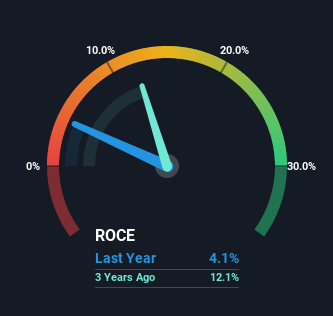If we're looking to avoid a business that is in decline, what are the trends that can warn us ahead of time? When we see a declining return on capital employed (ROCE) in conjunction with a declining base of capital employed, that's often how a mature business shows signs of aging. This combination can tell you that not only is the company investing less, it's earning less on what it does invest. So after we looked into Burelle (EPA:BUR), the trends above didn't look too great.
Understanding Return On Capital Employed (ROCE)
Just to clarify if you're unsure, ROCE is a metric for evaluating how much pre-tax income (in percentage terms) a company earns on the capital invested in its business. The formula for this calculation on Burelle is:
Return on Capital Employed = Earnings Before Interest and Tax (EBIT) ÷ (Total Assets - Current Liabilities)
0.041 = €169m ÷ (€7.1b - €3.0b) (Based on the trailing twelve months to June 2022).
So, Burelle has an ROCE of 4.1%. Ultimately, that's a low return and it under-performs the Auto Components industry average of 6.0%.
View our latest analysis for Burelle

Historical performance is a great place to start when researching a stock so above you can see the gauge for Burelle's ROCE against it's prior returns. If you're interested in investigating Burelle's past further, check out this free graph of past earnings, revenue and cash flow.
The Trend Of ROCE
There is reason to be cautious about Burelle, given the returns are trending downwards. To be more specific, the ROCE was 15% five years ago, but since then it has dropped noticeably. And on the capital employed front, the business is utilizing roughly the same amount of capital as it was back then. Companies that exhibit these attributes tend to not be shrinking, but they can be mature and facing pressure on their margins from competition. If these trends continue, we wouldn't expect Burelle to turn into a multi-bagger.
On a separate but related note, it's important to know that Burelle has a current liabilities to total assets ratio of 42%, which we'd consider pretty high. This can bring about some risks because the company is basically operating with a rather large reliance on its suppliers or other sorts of short-term creditors. While it's not necessarily a bad thing, it can be beneficial if this ratio is lower.
The Bottom Line
In summary, it's unfortunate that Burelle is generating lower returns from the same amount of capital. Long term shareholders who've owned the stock over the last five years have experienced a 60% depreciation in their investment, so it appears the market might not like these trends either. Unless there is a shift to a more positive trajectory in these metrics, we would look elsewhere.
One final note, you should learn about the 3 warning signs we've spotted with Burelle (including 1 which is concerning) .
While Burelle isn't earning the highest return, check out this free list of companies that are earning high returns on equity with solid balance sheets.
Valuation is complex, but we're here to simplify it.
Discover if Burelle might be undervalued or overvalued with our detailed analysis, featuring fair value estimates, potential risks, dividends, insider trades, and its financial condition.
Access Free AnalysisHave feedback on this article? Concerned about the content? Get in touch with us directly. Alternatively, email editorial-team (at) simplywallst.com.
This article by Simply Wall St is general in nature. We provide commentary based on historical data and analyst forecasts only using an unbiased methodology and our articles are not intended to be financial advice. It does not constitute a recommendation to buy or sell any stock, and does not take account of your objectives, or your financial situation. We aim to bring you long-term focused analysis driven by fundamental data. Note that our analysis may not factor in the latest price-sensitive company announcements or qualitative material. Simply Wall St has no position in any stocks mentioned.
About ENXTPA:BUR
Burelle
Through its subsidiaries, provides automotive equipment in France and internationally.
Good value with adequate balance sheet and pays a dividend.
Market Insights
Community Narratives




